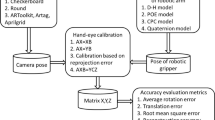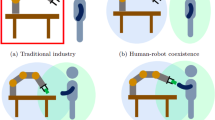Abstract
The macro positioning stage with high-precision and rapid positioning ability plays a crucial role in the macro-micro combination positioning system. In this paper, we develop a practical method for the control of a 3-RRR planar positioning system using online vision measurement as feedback. In this method, a monocular vision system is established to accomplish high-precision online pose measurement for the 3-RRR manipulator. Additionally, a robust and operable adaptive control algorithm, which incorporates a fuzzy controller and a PI controller, is employed to achieve precise and rapid positioning of the 3-RRR positioning system. A series of experiments are conducted to verify the positioning performances of the proposed method, and a conventional PI control algorithm is utilized for comparison. The experimental results indicate that using the proposed control approach, the parallel positioning system obtains high precision and shows higher efficiency and robustness, especially for the time-varying positioning system.
Similar content being viewed by others
References
Fatikow S, Eichhorn V, Krohs F, et al. Development of automated microrobot-based nanohandling stations for nanocharacterization. Microsyst Technol, 2008, 14: 463–474
Gupta R, Cavanah T M, Panhuis I H M. Nanomanipulation of individual carbon nanotubes. Microsc Microanal, 2004, 10: 962–963
Fahlbusch S, Mazerolle S, Breguet J M, et al. Nanomanipulation in a scanning electron microscope. J Mater Process Technol, 2005, 167: 371–382
Tran A V, Zhang X, Zhu B. The development of a new piezoresistive pressure sensor for low pressures. IEEE Trans Ind Electron, 2017
Wang R, Zhang X. Parameters optimization and experiment of a planar parallel 3-DOF nanopositioning system. IEEE Trans Ind Electron, 2018, 65: 2388–2397
Merlet J P. Jacobian, manipulability, condition number, and accuracy of parallel robots. J Mech Des, 2006, 128: 199–206
Gao F, Qi C K, Ren A Y, et al. Hardware-in-the-loop simulation for the contact dynamic process of flying objects in space. Sci China Tech Sci, 2016, 59: 1167–1175
Yao S, Zhang X, Yu J, et al. Error modeling and calibration of a 4RR redundant positioning system. AIP Adv, 2017, 7: 095009
Yu J J, Dai J S, Bi S S, et al. Type synthesis of a class of spatial lowermobility parallel mechanisms with orthogonal arrangement based on Lie group enumeration. Sci China Tech Sci, 2010, 53: 388–404
Li Q, Wu F X. Control performance improvement of a parallel robot via the design for control approach. Mechatronics, 2004, 14: 947–964
Vivas A, Poignet P. Predictive functional control of a parallel robot. Control Eng Pract, 2005, 13: 863–874
Korayem M H, Tourajizadeh H, Taherifar M, et al. A novel method for recording the position and orientation of the end effector of a spatial cable-suspended robot and using for closed-loop control. Int J Adv Manuf Technol, 2014, 72: 739–755
Shang W, Cong S. Motion control of parallel manipulators using acceleration feedback. IEEE Trans Contr Syst Technol, 2014, 22: 314–321
Shang W W, Cong S, Ge Y. Adaptive computed torque control for a parallel manipulator with redundant actuation. Robotica, 2012, 30: 457–466
Yang H, Shao L, Zheng F, et al. Recent advances and trends in visual tracking: A review. Neurocomputing, 2011, 74: 3823–3831
Li H, Zhang X, Zhu B, et al. Micro-motion detection of the 3-DOF precision positioning stage based on iterative optimized template matching. Appl Opt, 2017, 56: 9435–9443
Wu H, Zhang X, Gan J, et al. High-precision displacement measurement method for three degrees of freedom-compliant mechanisms based on computer micro-vision. Appl Opt, 2016, 55: 2594–2600
Cheng H, Yiu Y K, Li Z. Dynamics and control of redundantly actuated parallel manipulators. IEEE/ASME Trans Mechatron, 2003, 8: 483–491
Yong Y K, Lu T F, Minase J. Trajectory following with a three-DOF micro-motion stage. In: Australasian Conference on Robotics and Automation. ACRA, 2006. 6–8
Ren L, Mills J K, Dong Sun J K. Trajectory tracking control for a 3- DOF planar parallel manipulator using the convex synchronized control method. IEEE Trans Contr Syst Technol, 2008, 16: 613–623
Vermeiren L, Dequidt A, Afroun M, et al. Motion control of planar parallel robot using the fuzzy descriptor system approach. ISA Trans, 2012, 51: 596–608
Wu J, Wang J, Wang L, et al. Dynamics and control of a planar 3-DOF parallel manipulator with actuation redundancy. Mechanism Machine Theor, 2009, 44: 835–849
Wu J, Wang D, Wang L. A control strategy of a two degrees-offreedom heavy duty parallel manipulator. J Dyn Sys Meas Control, 2015, 137: 061007
Wu J, Wang J, You Z. An overview of dynamic parameter identification of robots. Robot Comput Integr Manuf, 2010, 26: 414–419
Wang D, Wu J, Wang L, et al. A method for designing control parameters of a 3-DOF parallel tool head. Mechatronics, 2017, 41: 102–113
Bonev I A, Gosselin C M. Singularity loci of planar parallel manipulators with revolute joints. In: Proceedings of the 2nd Workshop on Computational Kinematics. Seoul, 2001. 291–299
Gosselin C, Angeles J. The optimum kinematic design of a planar three-degree-of-freedom parallel manipulator. J Mech Trans, 1988, 110: 35–41
Liu X J, Jin Z L, Gao F. Optimum design of 3-DOF spherical parallel manipulators with respect to the conditioning and stiffness indices. Mechanism Machine Theor, 2000, 35: 1257–1267
Lepetit V, Moreno-Noguer F, Fua P. EPnP: An accurate O(n) solution to the PnP problem. Int J Comput Vis, 2009, 81: 155–166
Zhang Z. A flexible new technique for camera calibration. IEEE Trans Pattern Anal Machine Intell, 2000, 22: 1330–1334
Wang L X. A Course in Fuzzy Systems. Upper Saddle River, NJ: Prentice-Hall Press, 1999
Ziemer R E, Tranter W H, Fanin D R. Signals and Systems: Continuos and Discrete. Upper Saddle River, NJ: Prentice-Hall Press, 1998
Salas F G, Santibáñez V, Llama M A. Fuzzy-tuned PD tracking control of a 3-RRR parallel manipulator: Stability analysis and simulations. Intell Autom Soft Comput, 2014, 20: 159–182
Zhang X, Zhang X. A comparative study of planar 3-RRR and 4-RRR mechanisms with joint clearances. Robot Comput Integr Manuf, 2016, 40: 24–33
Author information
Authors and Affiliations
Corresponding author
Rights and permissions
About this article
Cite this article
Yao, S., Li, H., Zeng, L. et al. Vision-based adaptive control of a 3-RRR parallel positioning system. Sci. China Technol. Sci. 61, 1253–1264 (2018). https://doi.org/10.1007/s11431-017-9181-9
Received:
Accepted:
Published:
Issue Date:
DOI: https://doi.org/10.1007/s11431-017-9181-9




